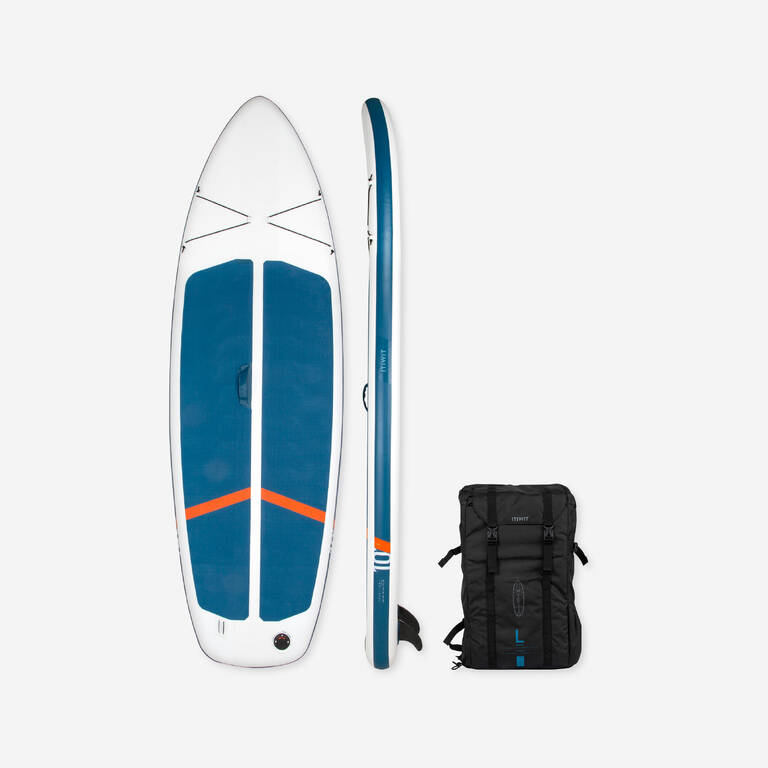Technical dimensions
INFLATABLE BOARD:
Length: 10’ (305 cm)
Width: 35" (89 cm)
Thickness: 6" (15 cm)
Volume: 325 litres
Weight: 8 kg (±5%)
When folded:
Height: 60 cm
Width: 38 cm
Thickness: 22 cm
30 L (approx.) carry bag that can hold the pump and paddle on the outside.
What is the recommended user weight and maximum load of the board?
Designed for riders up to 130 kg without compromising paddling quality.
Less than 60 kg: ultra-stable board.
60 to 80 kg : very stable board.
Over 80 kg: ideal board for easily starting out.
The board can be used by multiple people:
- 1 adult standing + 1 or 2 children (seated or kneeling)
- 1 adult standing + 1 adult (seated or kneeling)
Maximum load to stay above the water: < 325 kg.
How do you inflate and deflate a stand-up paddleboard?
INFLATION:
The SUP is equipped with a new-generation valve to guarantee even more security.
To inflate your SUP, open the cap and connect the pump (“IN” mode).
Inflate to 15 psi for best results.
Disconnect the pump and close the outer cap.
DEFLATING:
Turn the cap a quarter clockwise (“OUT” mode).
Roll, starting from the opposite side to the valve to remove all the air for tight folding.
Close the cap.
How should I store my board and where to leave it to dry?
Never leave your board out of the water in direct sunlight.
If you have to leave your board in the sun, we recommend keeping it away from any sources of heat (walls, floors, car roofs, etc.) and reducing the pressure to 10 psi in order to prevent overpressure and irreversible damage (explosion, delamination, leaks, etc.).
Excluding transport, you don’t need its extreme compactness, preferably storing it inflated or rolled lengthways.
Which folding method?
Completely deflate the board.
Roll up the product a first time to expel the air through the open valve.
Unroll the board and lay out flat. Fold it lengthways with the fin bases positioned outwards.
Roll up from front to back.
Use the compression strap to keep it rolled up and help you fit it into the bag.
For more details, check out our videos online available on the product page.
Fins and fin bases
2 118 mm fins for paddling in shallow water.
Available from our after-sales service and online if lost or broken (8502106)
Remember to remove the fins once you get off the water.
For your safety, protect your hand if you need to apply force to the rear of the fin to remove it in the event of blockage with sand.
If possible, rinse the bases of the fins before and after using the stand-up paddle board for easier fin installation and removal.
How can I repair my stand-up paddleboard?
We have a stand-up paddleboard repair kit under the reference 8512384 for repairing small, easily visible leaks.
For all other repairs, we recommend that you contact the workshop of your local shore.
We can repair bases of the fins, handles, valves and significant leaks
Leash
Very lightweight leash that you won’t even know is there during use and is easy to store.
Always wear your leash to stay attached to your board if you fall.
To avoid damaging the leash and leaving marks on your folded board, remove and rinse after each use.
This leash attaches to the ankle.
CAUTION: don’t use the leash on the river.
Backpack
A redesigned volume for easier storage.
Foam carry straps for more comfort.
A side pocket to attach our compact paddle (8643049)
Two elastics to attach your pump.
What’s in the bag?
Compact board L: 10’
Fins x2
Leash
User guide
Repair patch (adhesive not included)
Valve tightening tool (use only when the SUP is deflated)
What do I do with the tightening tool in the SUP bag?
NEVER UNSCREW THE VALVE WHEN THE SUP IS INFLATED! RISK OF INJURY.
If the valve leaks, once the SUP is deflated, close it a quarter turn using the tool provided.
If necessary, it is possible to change the valve, please consult the workshop of your Decathlon store.
Directions for use
We recommend:
Using a buoyancy aid jacket (reference 8552970) or a buoyancy aid belt (reference 8600104)
Not suitable for paddling further than 300 m from shelter.
Do not use the leash on rivers.
Notify someone of your trip and your whereabouts.
Research to find out if there are any local navigation rules that apply to the location of your trip.








































































